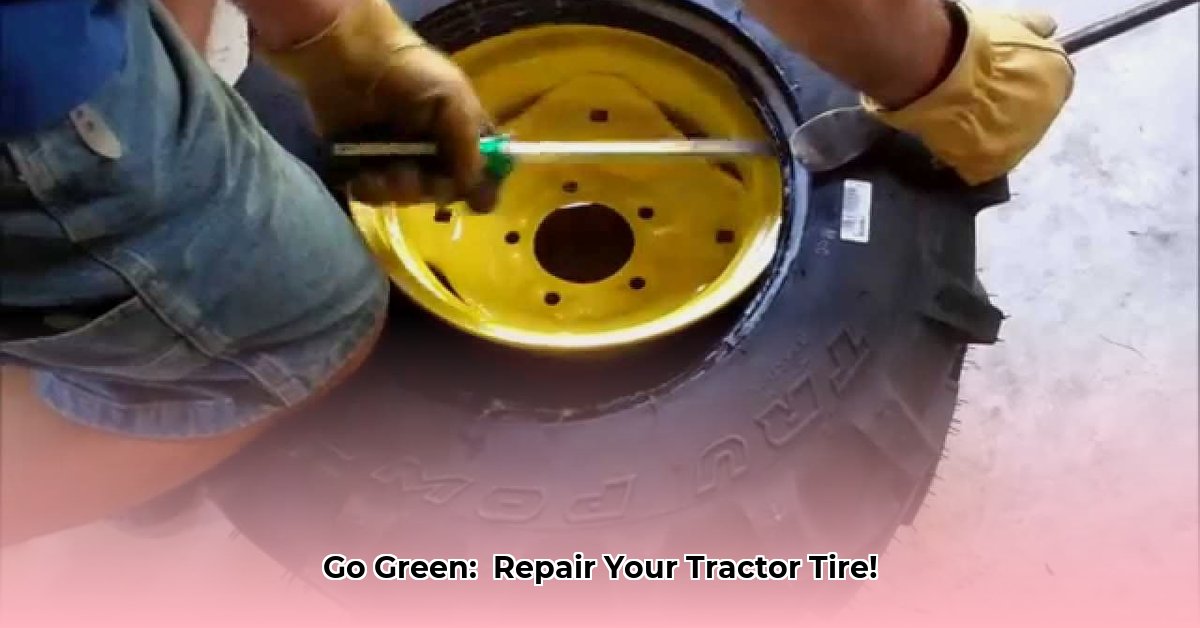
Changing a tractor tire can seem intimidating, but with the right approach and a little patience, it's a manageable task. This guide provides a step-by-step process, emphasizing safety and environmentally conscious practices to extend tire life and minimize waste. For a more visual guide, check out this helpful resource.
Getting Ready: Tools, Safety, and Preparation
Before you begin, gather the necessary tools and ensure your safety. Improper preparation can lead to injury or damage. This step is crucial for a successful tire change.
- Heavy-duty jack: A jack capable of lifting your tractor safely.
- Wheel chocks: To prevent the tractor from rolling during the process.
- Tire irons (various sizes): Metal levers for removing and installing the tire.
- Bead breaker: A tool to separate the tire bead from the rim (makes removing the tire much easier).
- Lug wrench: To remove and tighten the lug nuts securing the wheel.
- Safety glasses and heavy-duty gloves: To protect your eyes and hands.
- New tractor tire: Ensure it's the correct size and type for your tractor (check the sidewall of your old tire for specifications).
- Wheel balancer (optional): For a smoother ride and improved tire longevity.
Safety First: Always work on a level surface with the parking brake engaged and wheel chocks in place. Never work under a raised tractor without secure support.
Removing the Old Tire
This section details the removal of the worn-out tire. Remember, patience is key, and taking your time significantly improves safety.
- Secure the Tractor: Use wheel chocks on the wheels opposite the one you're working on.
- Lift the Wheel: Carefully jack up the wheel until it's clear of the ground.
- Remove Lug Nuts: Loosen and remove the lug nuts, keeping them together in a safe place. Remove the wheel assembly.
- Deflate the Tire: Completely deflate the old tire for easier handling.
- Break the Bead: Use the bead breaker to separate the tire bead from the rim, working your way around the entire tire.
- Remove the Tire: Use tire irons to carefully pry the tire off the rim. This requires effort; take breaks as needed.
Installing the New Tire
Here's how to safely install the replacement tire. Proper installation ensures proper tire function and longevity.
- Inspect the Rim: Check the wheel rim for any damage; bent rims can cause premature tire wear.
- Mount the Tire: Work the tire bead onto the rim, starting with one side and then the other.
- Partial Inflation: Inflate the tire slightly to help the bead seat onto the rim.
- Seat the Bead: Continue inflating until the bead snaps firmly into place all the way around. (Use a bead seater if needed).
- Final Inflation: Inflate to the manufacturer's recommended pressure (found on the tire sidewall).
- Remount the Wheel: Carefully align the wheel with the hub and attach the lug nuts.
- Lower the Tractor: Slowly lower the tractor, ensuring the wheel remains aligned.
- Tighten Lug Nuts: Tighten the lug nuts to the manufacturer's specified torque (check your tractor's manual).
Sustainability and Eco-Friendly Practices
Choosing sustainable options and utilizing best practices extends tire life and reduces environmental impact.
- Long-lasting Tires: Prioritize tires with longer tread life to reduce replacements.
- Proper Inflation: Maintain proper tire pressure to increase fuel efficiency and tire lifespan. Did you know that underinflation can reduce tire life by up to 25%?
- Tire Recycling: Utilize recycling options for your old tires to prevent landfill waste. Recycling a single tire can save up to 1 gallon of oil and 40 pounds of greenhouse gas emissions!
- Preventative Maintenance: Regular tire inspections and maintenance prevent premature wear.
Troubleshooting and Helpful Hints
- Stubborn Bead: Use a lubricant (like soapy water) if the tire bead is difficult to remove.
- Tire Damage: If your old tire shows damage, inspect the wheel balance and tractor suspension.
- Incorrect Size: Using incorrect tire sizes leads to rapid wear and potential damage.
By following these steps, you can successfully replace your tractor tire while minimizing your environmental impact. Remember: safety and careful execution are key to a successful outcome. Consistent maintenance is a cornerstone of sustainable farming practices. What other proactive measures do you employ to enhance your farm's ecological footprint?